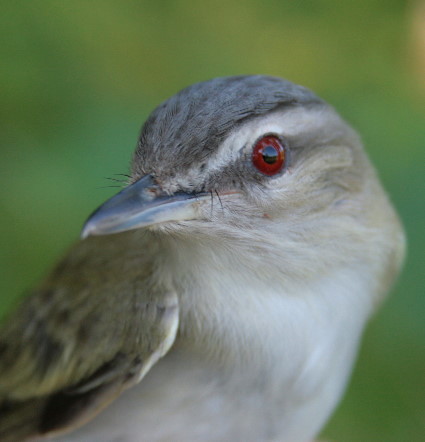That's a comment overheard at the last Nature Calgary Bird Study Group meeting. As we approach late September in Alberta there is a certain inevitability to the first snowfall and it will indeed chase away many lingering migrants. With an uncertain and dwindling number of good migratory birding days left, I've been trying to squeeze in a few trips.
On Friday morning I managed to swing by Confederation Park on my way to school. Large flocks of Wilson's and Yellow-rumped Warblers were a nice way to start the day. My NMT list (explanation here) grew as well, with Orange-crowned Warbler, Ruby-crowned Kinglet, and (with the help of some experienced fellow birders) a Red-eyed Vireo.
 |
| Red-eyed Vireo looks like it means business! Image From Flickr Creative Commons taken by SeabrookeLeckie.com |
Feeling suitably pumped up by that experience I dragged myself out of bed in the dark this morning and headed out to Namaka Lake, 70km SE of the city near Strathmore. This is a designated Important Bird Area and a spot that I had been wanting to check out for some time. Namaka certainly made a great first impression. A fiery sunrise lit up the sky ahead of me all the way there and I arrived at the east access point five minutes before the sun broke the horizon. As I walked towards the lake the grass was lit up golden brown. I couldn't resist the urge to stride through stands that were five feet high, with the loaded ears bouncing off my chest sending seeds for next year flying out in all directions.
Overblown pastoral prose aside, the lighting was pretty great for the birds too. One of the first that I saw was a Le Conte's Sparrow. A life bird for me and, based on my reading back at home, an amazingly cooperative example of its kind!
On the lake itself there was no shortage of bird life either. A few late shorebirds were hanging around the shoreline: a flock of Semipalmated Sandpipers hanging out with a couple of Lesser Yellowlegs, and a few Killdeer scattered around. The waterfowl were much more numerous with American Coot, and three Grebe species (Eared, Horned, and Western) being particularly noticeable. The real treat on the water though was the American White Pelicans.
The flocks of pelicans gorging themselves was quite a sight and I captured some digiscope video.
 |
| Le Conte's Sparrow, click to enlarge, image colour has not been manipulated - the sunrise was just this awesome! |
 |
| I know it's out of focus but this image cracks me up for some reason. American White Pelican and a family of Ruddy Ducks |
The video looks pretty decent in fullscreen. Sorry about the sniffling - it was a cool but great morning of birding!



